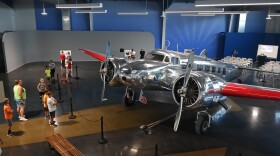-
Founded by settlers in 1837, Hermann was dedicated as a place where German Americans could preserve their culture. Now its annual Hermann Wurstfest draws crowds with sausage sampling, competitions, and a Wiener Dog Derby.
-
Bruce R. Watkins Drive took three decades to build, and resulted in the destruction of 2,000 homes and the displacement of thousands of Black residents. Kansas City officials and longtime residents hope a new federal grant can reconnect the neighborhoods torn apart by Highway 71, but mending old wounds won’t be easy.
-
Pfc. Willy F. James Jr. was among seven African American troops unjustly denied the country’s highest military award for valor during World War II. Veterans and service members at James' memorial shared their thoughts on his legacy.
-
Conservative legislators nationwide, including in Kansas, have introduced bills to restrict or criminalize certain drag performances. But drag queens haven’t stopped performing.
-
Since Kansas City was established, drag in various forms has evolved from entertainment for power and control into a liberating art. Attempts to regulate the practice have also persisted.
-
St. Louis County restored the only known remaining African American school in the county. During the 1900s, African Schoolhouse No. 4 held about 20 Black children each school year before it closed in 1950.
-
The White Castle chain began in 1921 in Wichita, Kansas, where its ingenious small burgers kicked off a national craze and inspired imitators of all shapes and sizes. But over a century later, White Castle has entirely vanished from its home state. And the story of how it introduced America to the hamburger has largely been overshadowed by its fast food rivals.
-
During a span of 71 years, most of the mounds in St. Louis left by Indigenous people from centuries earlier — some of which contained the remains of ancestors — were destroyed to make way for urban development. The ones that remain are left beneath bridges and inside parking garages.
-
Spread across two coffee shops and a bookstore, the “Black/Queer Kansas City” exhibit will showcase forgotten figures of local LGBTQ history — and hopefully encourage more Kansas Citians to share their own stories.
-
After they first began arriving in Missouri in the 1830s, German immigrants helped shape the state's culture in myriad ways, as detailed in the book “Explore Missouri's German Heritage” and the documentary it inspired.
-
A historical marker in Clayton, Missouri, declared that St. Louis County was “first visited by white colonists” in the early 1700s. The sign was taken down this past November, but a professor says it was a missed opportunity for change.
-
On Jan. 21, Washington Chapel C.M.E. Church was broken into and a piece of a memorial stained glass window removed. The church was built in 1907 by formerly enslaved families in Parkville, Missouri.
-
The Neck neighborhood was in the center of historic Independence and housed the biggest Black community in the city. When the Harry S. Truman Library was built to honor the president, urban renewal policies he put in place destroyed the neighborhood.
-
The Great War depleted the states’ National Guard troops, sending them overseas. Missouri was one of the states that backfilled the domestic duties with unpaid volunteers.
-
Cemeteries used to serve as parks. Can Kansas City's historic Elmwood Cemetery revive the tradition?Members of the Elmwood Cemetery Society hope the 150-year-old graveyard can once again be a place for family picnics and walks.
-
Sept. 21 marked the anniversary of when the Otoe-Missouria tribe was forced out of their lands, which would later become the city of Lincoln, Nebraska, and moved to a reservation in Oklahoma. Now the tribe hopes the day will serve as an annual reminder of reconciliation.
-
Central United Methodist Church will become a satellite for the Leawood-based Church of the Resurrection. Its history says much about Kansas City's, and it's own, past ties to slavery.
-
If you nerd out to concrete, steel and epic feats of engineering — or simply admire the bridges you cross on the way to work — read on.
-
Much of the Great Plains is way behind on moisture. The drought has drained water levels at many rivers and lakes, uncovering historical relics that are typically submerged.
-
In the 1890s, Kansas City businessmen William Nelson and August Meyer advocated for and started the Park Board. By 1895, the board had access to funding and the ability to condemn land for the purpose of establishing parks.
-
The Amelia Earhart Hangar Museum is slated to open in 2023. It honors the first woman to fly solo across the Atlantic Ocean.
-
As Kansas City’s first Black-owned housing co-op, Parade Park helped residents pursue the American Dream of owning a home and building a community. But after 60 years, it’s uncertain if it can survive foreclosure and redevelopment.
-
For generations, scientists seeking to learn about prehistoric ocean life have flocked to a place that’s about as far from the ocean as you can get — dry, dusty western Kansas. What they’re finding could teach us both about life in the ancient world and about the future of life in a changing climate.
-
Hear the towering – and polarizing – author in conversation about his 4,000-page book, The Oxford History of Western Music.



























